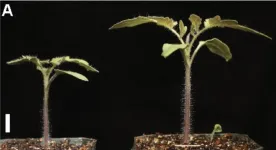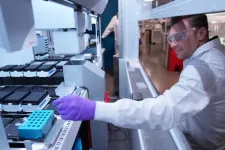(Press-News.org) Asymmetric synthesis and catalysis have been actively pursued in chemical and materials sciences. Increasing numbers of drugs and pesticides contain chiral structural units in their structures since drug actions require conformational matching to increase their potency and selectivity toward receptors and other active targets inside and on the surfaces of cells. Structural design of pharmaceuticals plays key role in reducing or avoiding severe side effects during their action processes. In the meanwhile, more advanced materials, especially nano and photoelectronic materials contain micro-and macro-chiral units requiring various levels of asymmetric factors. Therefore, the control of chirality will continue to play a crucial role in the aforementioned fields.
There have been four methods to control chirality including the use of chiral auxiliaries, reagents, solvents, and catalysts documented in literature and textbooks. Among them, asymmetric catalysts are normally divided into homogeneous and heterogeneous catalysis.
The Texas Tech University/Nanjing University Li Guigen team reports a new method for controlling chirality - asymmetric synthesis (AIAS) and asymmetric catalysis (AIAC) using chiral aggregates. This method is different from the five reported asymmetric synthesis methods: chiral auxiliary, chiral reagents, chiral solvents and chiral catalysts. These five methods are basically based on the reaction behavior of individual molecules in the reaction solution. The aggregation-induced asymmetric catalysis (AIAC) method is different from traditional homogeneous catalysis (single molecular behavior) and heterogeneous catalysis. It is a new type of asymmetric catalysis in between. AIAS is through the aggregation of chiral auxiliary raw materials, AIAC is through the aggregation of chiral catalysts to achieve the purpose of controlling chirality. Both of the new methods can be used to react with low or non-toxic solvents, and can achieve the purpose of improving stereoselectivity or controlling the opposite chiral configuration.
This work not only presented a new concept, but also confirmed it in asymmetric reaction processes through direct observation and evidence of molecular aggregation. Tang Y, Wang Y, Yuan Q, Zhang S, Wang JY, Jin S, Xu T, Pan J, Surowiec K, Li G. Aggregation-Induced Catalysis: Asymmetric Catalysis with Chiral Aggregates. Research 2023;6: Article 0163. https://doi.org/10.34133/research.0163
The Sharpless asymmetric catalytic dihydroxylation reaction (AD) was selected to represent this new concept and method owing to its simplicity with predictable asymmetric control by well-known and commercially available chiral ligands. The commercial AD-mixes containing the ligands (DHQ)2PHAL and (DHQD)2PHAL, referred to as AD-mix-α and AD-mix-b, respectively, were directly used for the reaction at room temperature. For the sake of aggregation, the co-solvents of THF-H2O commonly adopted in AIE (aggregation-induced emission) and AIP (aggregation-induced polarization) were employed for the present study instead of the traditional AD solvents of acetone, acetonitrile, alcohols together with water. Among many AD substrates, styrene and its derivatives were considered since they are best researched mechanistically in AD due to their simplicity.
The correlation of chiral aggregates to aggregation-induced polarization (AIP) was further explored to render optical rotation enhancement or adjustment as more polar solvent was added in co-solvents.(Fig 2) AIP measurements of chiral dimeric quinine ligands were conducted using a Rudolph polarimeter (Rudoph Research Analytica APIV/2W) with the sodium lamp emitting light at 589 nm as the light source. The samples were prepared at a consistent concentration (c = 2 mg/mL) in the cosolvents commonly employed AIE, and also for the present asymmetric dihydroxylation were thus utilized. The average specific rotation values taken from three measurements were considered the most authentic results and further plotted to relation curves with specific rotation on the Y axis. The water fraction was set at the component of 5% (v/v) on the X horizontal axis. As shown in Fig 2E and 2F, (DHQD)2PHAL demonstrated a substantial increase trend in the specific optical rotation values with gradually increased water fractions, from -186.5o to -132.5o during the water fraction’s changing from 0% to 65%. In contrast, (DHQ)2PHAL showed an opposite trend, which featured a consistent descending trend, in which the optical rotation value dramatically fell from 292.5o to 250 o.
This strategy demonstrated promising results on other reactions. For example, in the same co-solvent system containing THF and H2O, organocatalytic asymmetric Diels-Alder reaction between 1,3-diphenylisobenzofuran and (E)-but-2-enal depicted opposite enantioselectivity with respect to endo isomer by increasing fw values. This aggregation strategy would serve as a greener and more environmentally friendly tool of controlling chirality of products as compared with classical methods aforementioned. In the latter, in order to generate products of opposite chirality, the chirality of reactants, as well as catalysts or chiral solvents, needs to be reversed by performing synthesis of these materials, causing manpower and energy and producing more waste generation.
END
New research is tackling the mental health crisis in the construction industry – highlighting the benefits of an on-site Health Hub on worker wellbeing.
The construction industry has the highest number of deaths by suicide compared to other employment sectors, accounting for 20% of all suicides by occupation between 2011-2019 (ONS).
Now, in a joint collaboration between the University of Warwick and National Grid, researchers are attempting to address this problem.
A Health Hub was set up on a construction site in Sellindge, Kent which employees could use during their long working days. The Health Hub, a pilot for future projects which could be implemented ...
CABI joined an international team of researchers from 57 institutions around the world to share its expertise in a ground-breaking study which highlights the urgent need to protect the world’s forests from non-native pests amid climate change.
The study, led by Dr Iva Franić* – who at the time of the research was a PhD student co-supervised by CABI’s Dr René Eschen – stresses an urgent need to limit tree pests and enhance the resilience of forest ecosystems in the face of rising temperatures.
Published ...
During his presidency, Donald Trump and members of his administration repeatedly accused federal civil servants of undermining their agenda through the “deep state.” They sought to curtail career employees’ workplace protections, sought to severely cut some agencies’ funding, and in some cases attempted to undermine or alter agency missions.
Hamilton College Associate Professor of Sociology Jaime Kucinskas and Yvonne Zylan, an independent scholar, published the peer-reviewed “Walking the Moral Tightrope: Federal Civil ...
Exposing seedlings to ethylene in darkness increases size and vigor, in a finding with implications for agriculture. Farmers have worked to increase crop yields for millennia, and the quest remains urgent as the human population continues to grow. Increases in yield often come at a price, however: reductions in stress tolerance. Brad Binder and colleagues sought to increase plant yield without sacrificing hardiness by using to the gaseous plant growth hormone ethylene. Previous work established that seedlings grown in the dark and treated with ethylene show reduced growth and a distinctive hooked shape. However, the authors found that ...
Breast milk from each individual contains a unique assemblage of antibodies that are surprisingly stable throughout lactation and across pregnancies, according to a new Journal of Experimental Medicine study from the University of Pittsburgh School of Medicine.
As a baby’s early immunity is directed by antibodies from breast milk, the new research provides insight into why protection against different infections varies among infants and why some develop a life-threatening gut disease called necrotizing enterocolitis (NEC).
“While each milk donor in our study had very different antibody profiles from one another, we ...
Life on Earth didn’t arise as described in textbooks
No, oxygen didn’t catalyze the swift blossoming of Earth’s first multicellular organisms. The result defies a 70-year-old assumption about what caused an explosion of oceanic fauna hundreds of millions of years ago.
Between 685 and 800 million years ago, multicellular organisms began to appear in all of Earth's oceans during what's known as the Avalon explosion, a forerunner era of the more famed Cambrian explosion. During this era, sea sponges and other bizarre multicellular organisms replaced small single-celled ...
Relatives are a great resource in today's healthcare system. In Norway, relatives' efforts add up to approximately the same number of person-years as provided by the public municipal health and care services.
But the role of relatives is changing. Changes in the age composition of the population, changed social structures and family patterns will affect how many relatives each of us has to support us in the future.
In order to look after relatives in the best possible way, it is necessary to have increased knowledge about relatives' involvement and the need for support in various ...
HOUSTON ― The University of Texas MD Anderson Cancer Center today announced a
$16.25 million gift from Howard and Susan Elias to accelerate brain tumor and cancer neuroscience research, an emerging field focused on integrating the role of the nervous system in cancer. Howard Elias’ son, Harrison, was diagnosed with brain cancer and underwent successful surgery in 2000. Six years earlier, Howard’s father had died of glioblastoma. These separate diagnoses sparked a giving program over the years, leading to this latest gift which represents ...
SEATTLE — July 18, 2023 — In a significant milestone for the Allen Institute for Immunology, a division of the Allen Institute, researchers and staff will collaborate with private industry researchers to aid in the detailed molecular understanding of disease, in service of developing new treatments and therapies to improve human health.
Specifically, Allen Institute scientists will work with researchers from Eli Lilly and Company (Lilly) to investigate and profile disease state diversity and biomarkers for drug response involving atopic dermatitis (eczema) and rheumatoid arthritis using Allen Institute-developed ...
CEPI, the Coalition for Epidemic Preparedness Innovations, and the Houston Methodist Research Institute (HMRI), have today announced a partnership to combine cutting-edge artificial intelligence (AI) technology with established laboratory techniques to speed up development of future vaccines against novel viral threats (also known as Disease X). HMRI will lead a consortium including experts from Argonne National Laboratory (University of Chicago), J Craig Venter Research Institute, La Jolla Institute, The University of Texas Medical Branch, and The University of Texas, ...





